
The Cary family is an English aristocratic family with a branch in Ireland. The earliest known ancestor of the family is Sir Adam de Kari who was living in 1198. Sir John Cary purchased the Manor of Clovelly in the 14th century and established the family's status as members of the landed gentry. Various branches of the family were ennobled in the late 16th and early 17th centuries as Baron Hunsdon and Viscount Falkland.
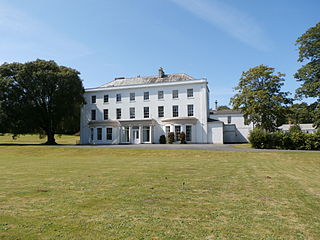
Moreton House is a grade II listed country house and former large estate near Bideford, North Devon, England. The house is about one mile west of the old centre of Bideford town, its entrance drive leading off the south side of the road between Bideford and the village of Abbotsham. It has in recent years become increasingly surrounded by the suburbs of Bideford, and in 2014 only 5 acres of the former parkland remain attached to the house. The estate is said anciently to have been the property of the famous Grenville family, lords of the Manor of Bideford, and of Stowe, Kilkhampton in Cornwall. It was later acquired by the Buck merchant family of Bideford, which rebuilt the house in 1760 and again in 1821.

Meavy is a small village, civil parish and former manor in the English county of Devon. Meavy forms part of the district of West Devon. It lies a mile or so east of Yelverton. The River Meavy runs near the village. For administrative purposes the parish is grouped with the parishes of Sheepstor and Walkhampton to form Burrator Parish Council, and for electoral purposes it is grouped with the same two parishes to form Burrator Ward.
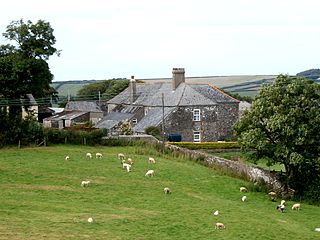
Halsbury is a historic manor in the parish of Parkham in North Devon, England. It is situated 2 miles north-east of the village of Parkham and 4 miles south-west of the town of Bideford. Halsbury was long a seat of the ancient Giffard family, a distant descendant of which was the celebrated lawyer Hardinge Stanley Giffard, 1st Earl of Halsbury (1823–1921), who adopted the name Halsbury for his earldom and was the author of the essential legal reference books Halsbury's Statutes. Halsbury Barton, now a farmhouse, retains 16th- and 17th-century elements of the former manor house of the Giffard family. It was described in a record of 1560 as a "new dwelling house".
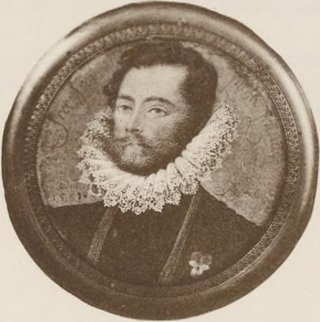
Sir George Carey, JP, DL, of Cockington in the parish of Tor Mohun in Devon, England, was Lord Deputy of Ireland from May 1603 to February 1604.

Doctor George Cary (1611–1680), Professor of Sacred Theology, lord of the manor of Clovelly, Devon, was Dean of Exeter between 1663 and 1680. He was also Rector of Clovelly and of Shobrooke in Devon and Chaplain in Ordinary to King Charles II. He was one of the Worthies of Devon of John Prince.

Weare Giffard is a small village, civil parish and former manor in the Torridge district, in north Devon. The church and manor house are situated 2 1/2 miles NW of Great Torrington in Devon. Most of the houses within the parish are situated some 1/2-mile east of the church. The church is situated on a hillside to the north and slightly above the wide and flat valley floor of the River Torridge. The Church of the Holy Trinity and the adjacent Weare Giffard Hall are designated members of the Grade I listed buildings in Devon.

Robert Carey, lord of the manor of Clovelly in North Devon, was Member of Parliament for Barnstaple, Devon, in October 1553 and served as Sheriff of Devon in 1555–56. He served as Recorder of Barnstaple after 1560. Along with several other members of the Devonshire gentry then serving as magistrates he died of gaol fever at the Black Assize of Exeter 1587. His large monument survives in Clovelly Church.

The landed gentry and nobility of Devonshire, like the rest of the English and European gentry, bore heraldic arms from the start of the age of heraldry circa 1200–1215. The fashion for the display of heraldry ceased about the end of the Victorian era (1901) by which time most of the ancient arms-bearing families of Devonshire had died out, moved away or parted with their landed estates.

Joseph Prust (1620–1677) of Annery, in the parish of Monkleigh, Devon, was a royalist military commander during the Civil War. He was a lieutenant colonel.
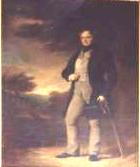
Lewis William Buck (1784–1858) of Moreton House, Bideford, and Hartland Abbey, Devon, was Member of Parliament for Exeter 1826–32 and for North Devon 1839–57, and was Sheriff of Devon in 1825/6. A full-length portrait of Lewis William Buck by Francis Grant (1803–1878) was presented to him by the people of North Devon after he had served eighteen years as their MP, now displayed in the billiards room of Hartland Abbey, with his electioneering posters on each side.
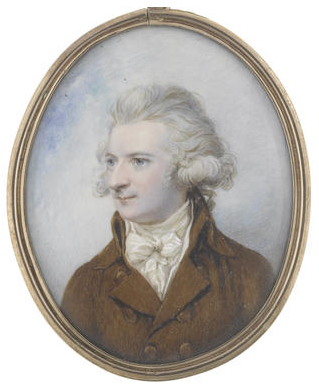
Sir James Hamlyn, 1st Baronet (1735–1811) of Clovelly Court in Devon, and of Edwinsford, Carmarthenshire, Wales, was a Member of Parliament (MP) for Carmarthen 1793–1802. He served as Sheriff of Devon in 1767–8. He was created a baronet in 1795. He not only inherited a large estate in Devon from his wealthy childless great-uncle, but also married a wealthy Welsh heiress.

Zachary Hamlyn (1677–1759), of Clovelly and Woolfardisworthy, three miles south-east of Clovelly, Devon, was a lawyer of Lincoln's Inn and thought to be the first Clerk of the Journals of the House of Commons. He made a large fortune and in 1738 purchased the manor of Clovelly from the last of the Cary family, longtime lords of the manor, and made Clovelly Court his residence.

Bableigh is an historic estate in the parish of Parkham in North Devon, England. It is separated from the village of Parkham by the Bableigh Brook. It was the earliest recorded seat of the Risdon family in Devonshire, from which was descended the Devon historian Tristram Risdon.

Sir Robert Spencer "of Spencer Combe" in the parish of Crediton, Devon, was the husband of Eleanor Beaufort (1431–1501), the daughter of Edmund Beaufort, 2nd Duke of Somerset (1406–1455), KG, and was father to two daughters and co-heiresses who made notable marriages.

Sir William Cary (1437–1471) of Cockington and Clovelly in Devon was a member of the Devonshire gentry. He was beheaded after the defeat of the Lancastrians at the Battle of Tewkesbury in 1471.
The Manor of Clovelly is a historic manor in North Devon, England. Within the manor are situated the manor house known as Clovelly Court, the parish church of All Saints, and the famous picturesque fishing village of Clovelly. The parish church is unusually well-filled with well-preserved monuments to the lords of the manor, of the families of Cary, Hamlyn, Fane, Manners and Asquith. In 2015 the Rous family, direct descendants via several female lines of Zachary Hamlyn (1677–1759) the only purchaser of Clovelly since the 14th century, still own the estate or former manor, amounting to about 2,000 acres, including Clovelly Court and the advowson of the parish church, and the village of Clovelly, run as a major tourist attraction with annual paying visitor numbers of about 200,000.

Sir Nicholas II Hooper (1654-1731) of Fullabrook, Braunton and Raleigh, Pilton in Devon, was a lawyer who served as Tory Member of Parliament for Barnstaple 1695-1715.

Docton is an historic estate in the parish of Hartland in Devon. The former "mansion house" situated 3 miles south-west of the village of Hartland was the residence of the Docton family from the 15th century. Today the estate having been split-up comprises separate holdings of Docton Farm, a working farm which operates holiday-let cottages including Waterwheel Cottage, Old Granary Cottage and Old Millhouse Cottage. Docton Mill, the estate's former corn mill, is now operated as award-winning tea-rooms with a garden open to the public. The arms of the Docton family were: Per fess gules and argent, two crescents in chief or another in base sable. These may be seen, amongst other places, in a 1933 stained glass window in St Nectan's Church, Hartland, by Townshend and Howson and on the ledger stone to Phillipa Cary (1603-1633) in Clovelly Church.
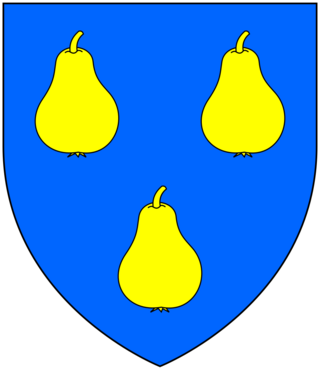
Sir Hugh Stucley (1496–1559) was the lord of Affeton in Devon, and Sheriff of Devon in 1545. His third son was Thomas Stukley, known as "The Lusty Stucley".

































